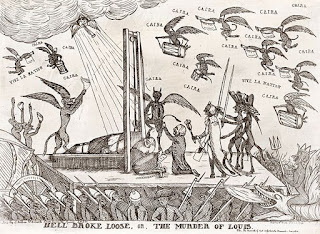In "The Gentleman & Ladies Companion containing the Newest Cotillions and Country Dances", published by the Norwich-based dancing master Trumbull in 1798, we find the following instructions for dancing the cotillion called.
The Ca Ira Cotillion
"Balance all eight, then half round the same back again; 1st and'2d couple (opposite) take your partner with both hands, chasse with her to your side with five steps, back again to your places balance with the opposite couple, then cross hands half round, back again with four hands round, a gentleman with the lady opposite balance in the middle, and set, the other gentleman with the opposite lady do the same, right and left quite round until to your places. The 3rd and 4th couples do the same figures."
"Ça ira", which can be translated as - it'll be fine - is a song of the French Revolution, first heard in May 1790. It underwent several changes in wording, all of which used the title words as part of the refrain.
The music is a popular contre danse air called Le Carillon National, composed by Bécourt, a musician of the théâtre Beaujolais. Marie Antoinette is said to have often played the music on her harpsichord.
The title and theme of the refrain were inspired by Benjamin Franklin while in France as a representative of the Continental Congress. Franklin was very popular in France. When asked about the American Revolutionary War, he would reportedly reply, "Ça ira, ça ira" ("It'll be fine, it'll be fine").
The song first became popular as a work song during the preparation for the Fête de la Fédération of 1790 and eventually became recognised as an unofficial anthem of revolutionaries.
At the 1793 Battle of Famars, the 14th Regiment of Foot, The West Yorkshire Regiment, attacked the French to the music of Ça Ira (the colonel commenting that he would "beat the French to their own damned tune"). The regiment was later awarded the tune as a battle honour and regimental quick march. It has since been adopted by the Yorkshire Regiment.
At the 1793 Battle of Famars, the 14th Regiment of Foot, The West Yorkshire Regiment, attacked the French to the music of Ça Ira (the colonel commenting that he would "beat the French to their own damned tune"). The regiment was later awarded the tune as a battle honour and regimental quick march. It has since been adopted by the Yorkshire Regiment.
 |
| Demons in the Sky sing "Ça ira" as the blade of the guillotine severs the head of Louis XVI in this British print published just four days after the king's execution on 21 January 1793. |
